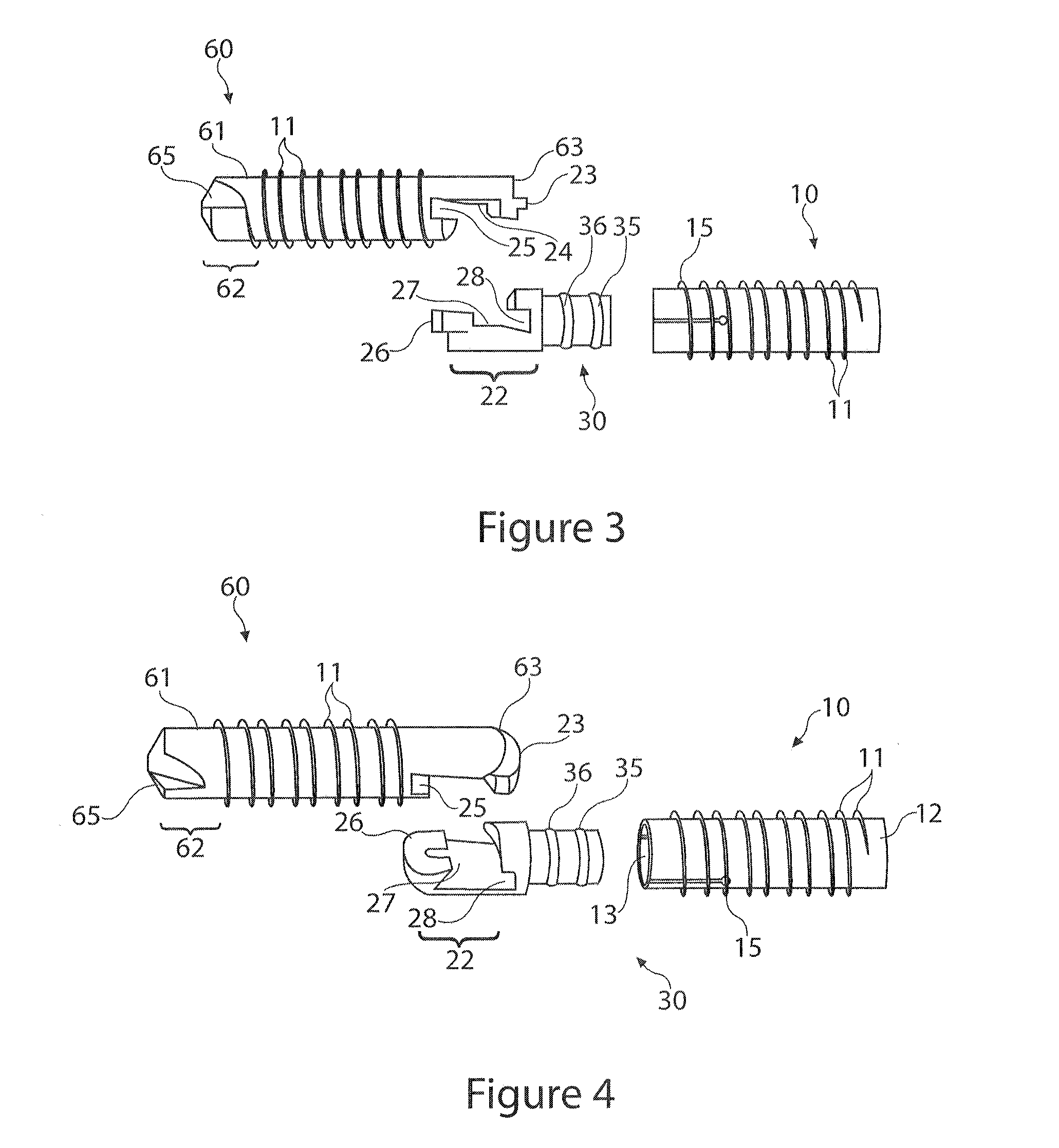Distal interphalangeal fusion method and device
a technology of distal interphalangeal fusion and joint fusion, which is applied in the field of medical devices and medical procedures, can solve the problems of inability to achieve esthetically pleasing, weaken grip strength, and extreme pain of joint disorders such as arthritis in the joints of digits, and achieve the effect of facilitating the coordination of screw threads
- Summary
- Abstract
- Description
- Claims
- Application Information
AI Technical Summary
Benefits of technology
Problems solved by technology
Method used
Image
Examples
example 1
Cannulated Flexible Three-Part DIP Fusion Apparatus
[0077]FIGS. 1-16, 32-33 disclose a first embodiment of the invention which may or may not be designed to be installed over a K-wire. The flexible bone fusion apparatus 5 of FIG. 1 comprises three main components, a compressor portion 10, coupler portion 30 and anchor portion 60. The coupler portion imparts overall flexibility to the design and allows the bone fusion apparatus to flex in a single plane at a DIP joint to emulate a natural curvature of the joint (e.g., finger or toe) post-fusion. FIG. 1 depicts all three components together in their unlocked assembled arrangement. When installing the device in bones such as either the finger or toe a cannulated delivery tool 100 (FIGS. 17-19) is inserted into the end of the assembled flexible bone fusion device 5. The delivery tool resembles a screwdriver in that it has a handle and shaft, but this tool is specially adapted to engage the compressor lumen of the bone fusion device throu...
example 2
Non-Cannulated Flexible Three-Part DIP Fusion Apparatus
[0101]Another embodiment of the DIP fusion apparatus employs an anchor portion 60 that does not have a cannula that opens to the leading tip and so would not be used with a K-wire. However, a cannula may be utilized through the anchor attachment portion 21. No separate figure shows this embodiment since to remove the opening is adequately disclosed by description only. With respect to FIGS. 5-8, in this alternate embodiment the anchor lumen / cannula 64 in anchor locking wedge 23, anchor axial face 24 and continuing through the anchor annular groove 25 would still exist. The delivery tool alignment pin 105 would engage the anchor as before, via coupler and through at least the anchor locking wedge part of the attachment assembly 20 (FIG. 1). With reference to FIG. 7, the tip hole 66 shown in the anchor leading tip 62 would not be present in this embodiment.
[0102]Compressor tool 110 shown in FIGS. 23-24 is a non-cannulated delivery...
example 3
Linear Two-Part Bone Fusion Apparatus
[0103]Another embodiment of the inventive concept disclosed herein is described and disclosed in FIGS. 28-31. In this embodiment the bone fusion apparatus does not flex about the coupler as the coupler's flex feature has been removed. Instead the apparatus comprises two components, an anchor portion and a compressor portion. This embodiment still accomplishes compression and fusion of two fractured parts or adjacent bones, although it has not been designed to flex about its longitudinal axis (long axis). The anchor portion is very similar to the anchor portion of the first example, although the trailing end has been modified to directly couple to the compressor portion. The compressor remains the same as the embodiments described in Example 1. Description of this embodiment is largely restricted to just those features that differ from the embodiments of Example 1, unless otherwise noted. If a feature is not noted in this example but it is visible...
PUM
 Login to View More
Login to View More Abstract
Description
Claims
Application Information
 Login to View More
Login to View More - R&D
- Intellectual Property
- Life Sciences
- Materials
- Tech Scout
- Unparalleled Data Quality
- Higher Quality Content
- 60% Fewer Hallucinations
Browse by: Latest US Patents, China's latest patents, Technical Efficacy Thesaurus, Application Domain, Technology Topic, Popular Technical Reports.
© 2025 PatSnap. All rights reserved.Legal|Privacy policy|Modern Slavery Act Transparency Statement|Sitemap|About US| Contact US: help@patsnap.com



